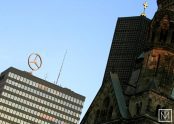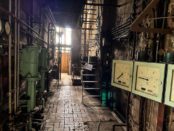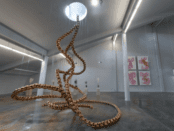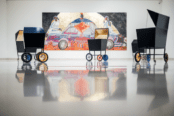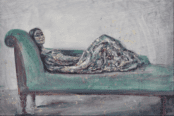[First in a series of dispatches from Gaza]
Today we are up early to film in Khuza’a, a town in Khan Younis, Gaza.
Around 12,000 people live in this previously vibrant place, with its beautiful buildings in an array of colours. It sits in southern Gaza Strip, near to the Israeli border.
Now, it is mostly destroyed.
Crumbling buildings, their innards spilling into the streets, stretch as far as the eye can see. The heat is almost unbearable, the road dissolved to sand, and people are everywhere. They are talking, clearing the street of rubble, sheltering under makeshift tents – their new homes, amid the rubble of their obliterated houses and apartments.
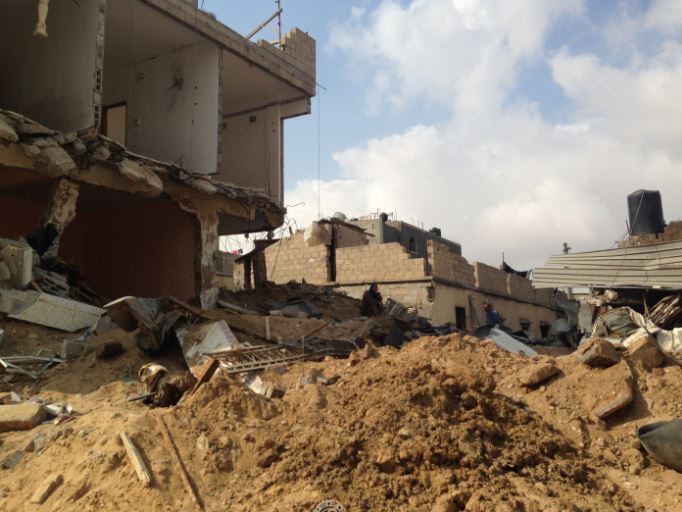 A Palastinian woman sits amid the rubble of her home
A Palastinian woman sits amid the rubble of her home
What happened here, between July 23rd and 25th, almost defies belief. Israeli forces wreaked a havoc the likes of which most of us could never imagine. Human Rights Watch have stated that repeated war crimes were committed by Israel on its brutal attack of Khuza’a. Their report reads:
Israeli forces in the southern Gaza town of Khuza’a fired on and killed civilians in apparent violation of the laws of war in several incidents.
These included repeated shelling that struck apparent civilian structures, lack of access to necessary medical care, and the threat of attack from Israeli forces as they tried to leave the area.
Israeli forces opened fire on civilians trying to flee Khuza’a, but no Palestinian fighters were present at the time and no firefights were taking place.
F-16s appeared in the skies at around 4am on the 23rd of July, 2014. First they dropped gas on the town, sending residents fleeing in panic, or choking, stricken in their beds. Those who could not leave their homes were blown to oblivion within them, or shot where they lay. Those who fled were fired on by Israeli troops.
One woman attempted to flee, carrying her baby son. She reports that an Israeli sniper shot him dead in her arms, and told her to leave him on the ground before they would let her leave.
We meet a family, sitting on mat, sheltered by tarpaulin. This is their home now. The list of their dead friends is past 80. They reared chickens and donkeys – most were massacred during the attacks. Chicken and donkey carcasses are scattered about the place. As if he had overheard the conversation and wished to express an opinion, one of the two remaining donkeys begins hee-hawwing and we need to stop filming while he settles again.
….
We move past the chickens into an open area. It is a moonscape opened up in the middle of the town. There were five houses here – not anymore. I speak with a 35-year-old woman who is eight months pregnant. She wears a green hijab, and black dress – her eyes are kind.
[quote]We will survive this.
We are going nowhere![/quote]
She was sleeping in her home, with her husband and seven children, when gas began to fill the rooms at 4am on July 23rd. They were forced to flee on foot and walk 6km through the night to reach the nearest aid facility. They returned the next morning to find their house had vanished to dust.
A neighbour’s house opposite was barely standing, so they went to check. They found six members of the family dead, their bodies melted one on top of the other in a single room. The husband shows me pictures of their bloated and blackened corpses on his phone. Gun shots are clearly visible in the bodies and the walls. These scenes speak to a mass execution in Khuza’a, of those residents who did not make it out. As Jesse Rosenfeld reported:
Blood and blackened remnants are caked on the bathroom floor. The walls have been drenched in blood and they are pocked with scores of bullet holes that look as if they were fired from an automatic weapon at waist level. Some of the bullet holes are in line, as if the gun were sweeping across its targets. There is also soot staining the tiles, suggesting the bodies were burned or there had been a small blast. Several tiles have fallen away from the wall. The house is filled with casings from the bullets used in assault rifles. They are marked on the bottom as “IMI” (Israel Military Industries).
These people were likely mown down as they huddled, praying the next bomb would not flatten them and their home.
I can feel the tears in my eyes as she explains she now lives under a sheet in this fly-infested patch of sand, with her seven children.
“You’re eight months pregnant….with seven children, and you are living in that?!” I point at the tent as outrage, anger, and sadness threaten to overwhelm me.
She nods and shrugs. She can’t stay at the UNRWA shelter because it’s too full, unsanitary and disease is spreading. They are safer here, under the shelter of their scraped-together tent.
She is washing clothes in a bowl of soapy water and somehow managing to smile.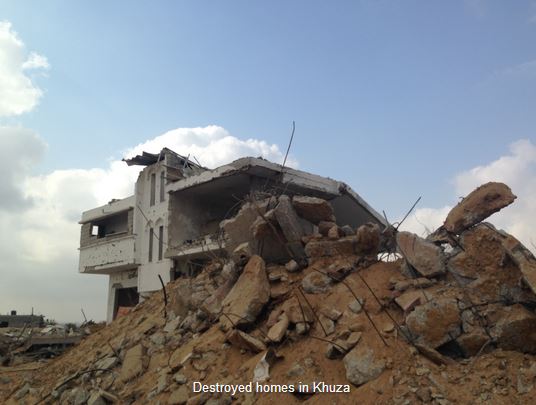
“We will survive this. We are going nowhere!”
I tell her she must be the bravest women I ever met. She smiles, takes my hand and looks into my eyes.
“Just tell the world we are people. Please.”
Palestinians are people. A people under siege and bombardment. They are being blown up, gunned down, gassed in their beds, and still have the grit and determination to stand defiant.
As we prepare to leave, a man repeats the same phrase I hear over and again here.
“We will not anymore live like animals. Let us live in dignity, or die with honour.”
With just hours left of the five-day ceasefire, and no peace deal yet agreed, Gaza is feeling a day of reckoning approaching. No one knows if the bombs will fall once more tonight. But they ready themselves, as best they can. Resilient amid the rubble.
You can see a short video as I pan across a street in Khuza’a below:
Kerry-Anne Mendoza is author of the Scriptonite Daily Blog: http://scriptonitedaily.wordpress.com
She is also a contributor to New Internationalist, openDemocracy and the Occupy News Network.
She is a writer, activist and campaigner for social, economic and environmental justice.


